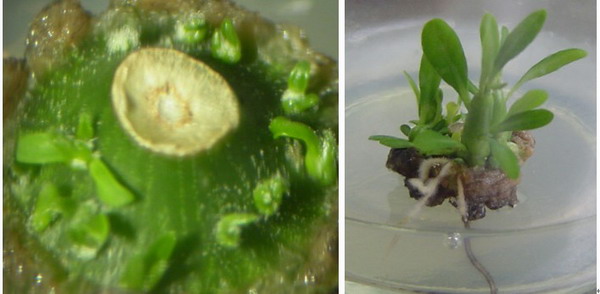Tissue Culture on Energy Plant Euphorbia tirucalli Achieves Success
The genus Euphorbia includes succulent shrubs distributing in tropical and subtropical regions of the world. These plants increase their biomass promptly in semi-deserts. Euphorbia plant cells accumulate sterols, di- and tri-terpenoids. The major components of Euphorbia latex are triterpenes; cracked or fermented latex can be used as fuel. Terpenoids and sterols in plants are also industrially important chemical sources as vitamins, steroid compounds, insecticides, and anticancer drugs.
Application of information to plant gene modification would be useful for production of transgenic plants with improved phytosterol production. Regeneration is a precondition and indispensable to introduce foreign genes to plants which contain important chemical substances. In this study, Prof. MA Guohua, WU Guojiang and their colleagues of South China Botanical Garden, CAS established a method without callus via direct adventitious shoot formation and plant regeneration in E. tirucalli. Adventitious buds induced from apical shoot explants of E. tirucalli were studied. On average, 10.5 adventitious buds were efficiently induced in an abnormal ring on the segment from one apical explant on MS medium supplemented with 0.5 mg l?1 thidiazuron and 0.5 mg l?1 benzylaminopurine. The adventitious buds could grow into adventitious shoots during subsequent cultures on hormone-free MS medium. For rooting, shoot clumps were cultured on half-strength MS medium containing 0.2 mg l?1 naphthalenacetic acid or indole-3-butyric acid. All the rooted plants survived established in soil within2 months. We expect our protocol to be usefulas the first step ofa protocol for its genetic modification.
Now the results of the study have been published in the international magazine, Journal of Plant Growth Regulation (2011, 30: 114-116).

Left: Adventitious shoots formation from apical shoot explant; Right: Growth of the adventitious shoots and induction of roots.
File Download: